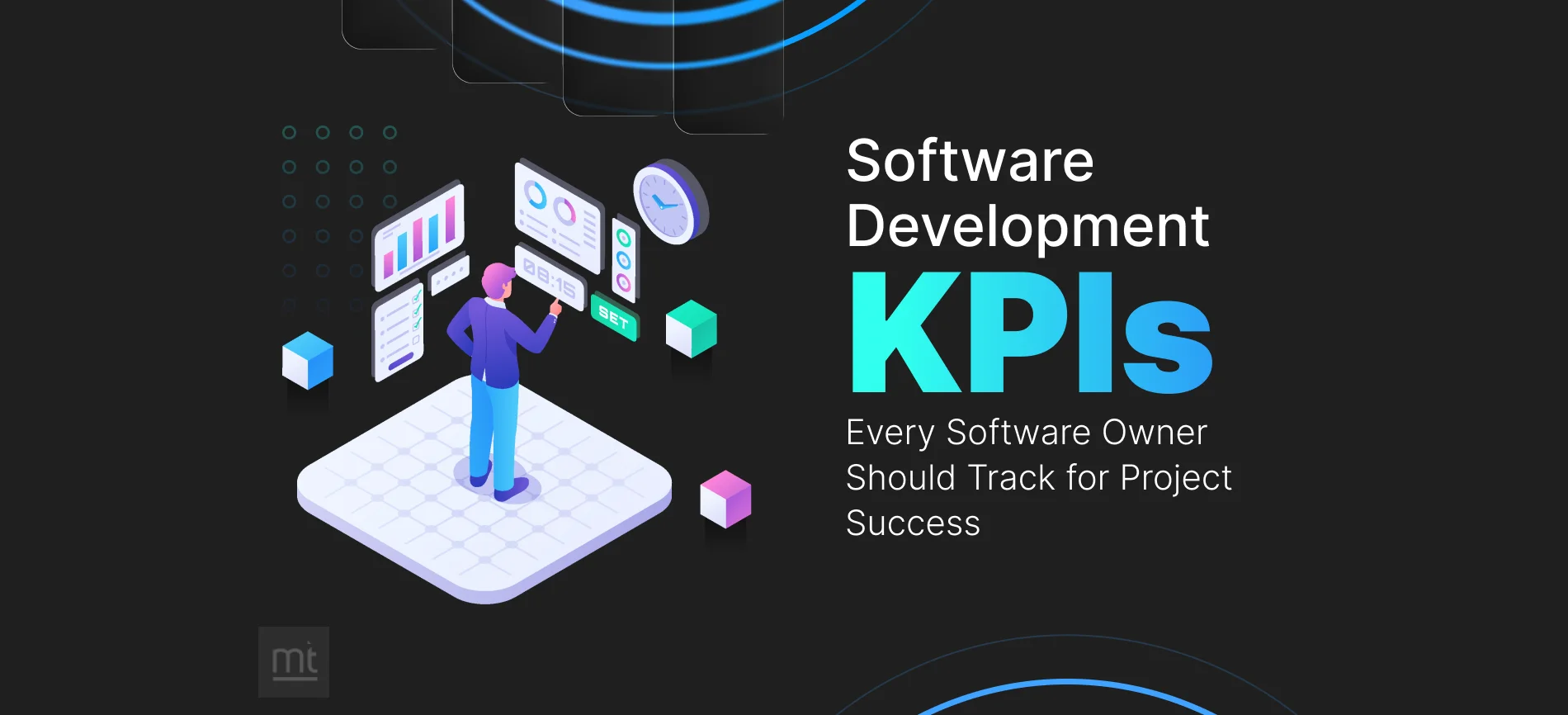Get Free Trial Week Developer Access, Try Before You Hire. Click Here to Claim Now
Introduction:
According to authors of Beyond Agile, Andrew Walker and Paul Scott, an average of 50% of projects fail. Of these, 32% fail due to poor project requirements while 23% failure has been attributed to poor communication (Gitnux).
Several CIOs have also stated that they are unable to deliver efficient and reliable solutions owing to fewer resources and more projects. This has also caused delays and budget overruns.
The unstructured processes combined with a chaotic testing method can lead to such management issues. That’s where the software development life cycle steps in. Providing a systematic and iterative approach to software development, this lifecycle process aims to reduce the timeline and improve quality.
The origins of software development life cycle can be dated back to the 60s, when large businesses wanted to find a way to simplify their complex app development processes.
This article will explore the importance of SDLC in modern software development, where time and reliability are key factors.
What is the Software Development Life Cycle (SDLC)?
Software Development Life Cycle is a structured framework that you can use to deliver reliable and high-quality usable software solutions. You will be able to offer user-centric and affordable solutions within the defined time frame.
As the entire lifecycle is divided into different phases, it makes delivering a large chunk of complex solution easy. Each phase comprises relevant activities and deliverables. You can create phase-wise goals that makes the process from software inception to actual deployment fast.
SDLC helps identify and mitigate the risks in the early stages. Moreover, you can handle the various issues and risks too. You can handle the different expectations and ensure resource management with an effective solution.
The SDLC gives importance to planning and analysis before you begin designing the software solution. In each phase, different stakeholders are involved in managing the expectations, handling the requirements and completing the solution.
With this approach, you can make software development approachable and predictable. It ensures that the software is able to meet the needs and deliverables proposed by the different stakeholders.
Why is SDLC Important?
Developers have been slowly transitioning to the SDLC approach. They have noticed several benefits associated with taking this reliable approach that can deliver a stable software solution. As it is guided by a proper plan and requirements understanding, it is a great way to approach software development. Let’s look at why SDLC is important for the business owner and developers.
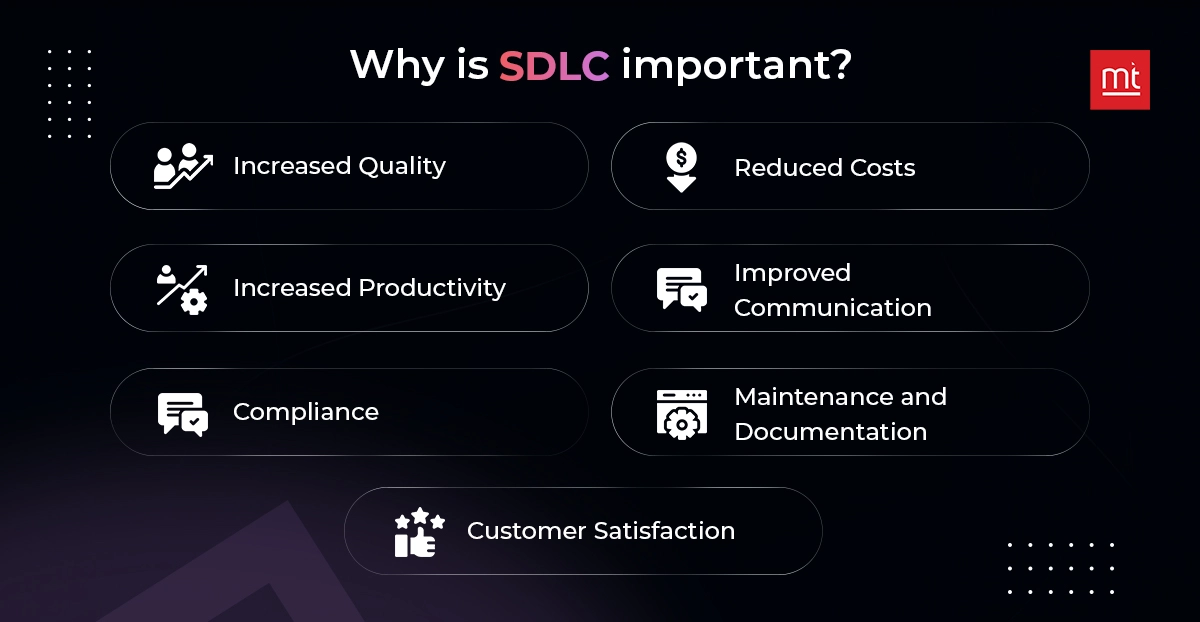
1. Increased Quality
What happens when you use SDLC to deliver your upcoming project? One, you proceed with a scope-based development. This means, your team is aware of the goals and inclusions for the software application.
Secondly, you would be testing the project thoroughly for functionality, performance and usability before launching them. This would ensure that the defects are identified in the early stages. As a result, you can deliver high quality software, which is one of the best benefits of SDLC.
2. Reduced Costs
When you work using a properly defined process, you can reduce the rework on your part. You go from the build stage into the testing phase, ensuring bug-free releases.
Moreover, during the build stage, you have already defined the blueprint for how you aim to create the code.
From considering factors that can improve productivity (read frameworks) to identifying the ways to enhance your code, you have planned for everything.
As a result, you won't be reworking on any part of the application development. This would minimize resource utilization and overall costs.
3. Increased Productivity
SDLC works with several workflows and automations. You can use software development tools and frameworks that can help you with building the software and enhancing the development.
As a result, this process leaves little to no room for redundancy. Moreover, you can use the functions well to optimize resource and budget allocation.
When your team is used for the core jobs while tools and workflows perform the repetitive tasks, it can increase productivity. As a result, you tend to release the software before the deadline.
4. Improved Communication
Using the software development lifecycle, you can ensure the perfect and seamless communication between different stakeholders. The developers can get a perfect view into the vision placed by the clients and their teams.
This would help define the project requirements, scope and the overall objectives. You can also ensure determining the expectations for the project over time.
5. Compliance
SDLC initiates standard practices into the development processes. You will be following the legal and regulatory needs posed by your software with time. This can help reduce the risks associated with development.
Moreover, you can mitigate the issues, identify potential bugs and intervene early in the regulatory aspects of the software development.
6. Maintenance and Documentation
This approach requires you to maintain thorough documentation throughout the development phases. This means, you need to work on documenting the changes, vision and the entire scope. It is equally important to document updates and enhancements.
At the same time, this process prioritizes maintenance and support. This is crucial if you want to offer extensive user support and ensure timely updates. You can also ensure enhancements in tune with your user’s requirements using proper maintenance methods.
7. Customer Satisfaction
The entire SDLC process is divided into several phases, taking into consideration the nuances of software development. For instance, the planning phase is devoted to thinking through the issues and problems you are likely to face with the development.
As a result, when you deliver the software, you produce a customer-centric and highly usable solution. This would increase their experience and enhance their satisfaction. You will also create a base of loyal customers with this approach.
What are the Benefits of the Software Development Lifecycle?
When you choose the software development lifecycle approach for building the solution, you will notice that it can help uplift your project in multiple ways. Let’s look at the benefits of using this approach for development.

#1. Provides a Structured Approach
Imagine beginning to develop the project only to realize you missed adding a few pieces. You go back to the scope, add a few more bits and then begin developing again. The cycle continues till you have no money or energy left to proceed.
With SDLC, you get a well-outlined and structured framework. This makes the whole development process predictable.
You will follow all aspects of the development consistently to produce a reliable solution. What makes the structure effective is the predictable nature.
#2. Improves Product Quality
When you prioritize validation, you will know if your users want the particular product or application. This would reduce the risk of developing a product that’s not aligned to your users.
The framework emphasizes delivering a high-quality solution by testing the solution and ensuring complete adherence to the compliances. This would mean delivering a high-quality and user-centric product. It can help you be more impactful.
#3. Reduces Budget Overruns
When you work with this structured method, you are aware of the scope of the project. This would ensure you don’t develop beyond what has been planned.
Secondly, you can detect the issues and problems in the early stages, thus resolving them. this would reduce the unnecessary resource allocation to resolve problems and fix the issues in the later stages.
As a result, you would notice that your entire project stays within the budget you had defined in the planning stage.
#4. Enhances Team Productivity
With this approach, you will fine-tune the frameworks that are best suited for developing the project. At the same time, you can create workflows to automate the repetitive elements of the project.
This would minimise the work for the developers and designers. As a result, they can work on creating efficient designs, effective code and foster innovation throughout the project.
This can also help align the different teams and ensure a more productive environment.
#5. Adaptable and Scalable Framework
There is no strict method of following the SDLC framework. That’s the beauty of the structured environment it offers. You can easily tailor it to use in various project types and sizes. Moreover, it can help you manage the evolving project requirements as well.
You will notice that the SDLC framework can be customised to suit your large-scale or small sized project effectively.
#6. Mitigates the Risk
With a software development lifecycle, you follow a structured process that begins with validating the idea to planning and finally developing. You will be able to recognize the flaws with the idea and the vision in the early stages itself.
This ensures quickly resolving the issues and reducing the chances of failure. It can also improve your decision-making abilities.
What are the Drawbacks of the Software Development Lifecycle?
Like every other model or framework, SDLC also poses several disadvantages and issues. Here is a list of the drawbacks and challenges you will face when using the approach.
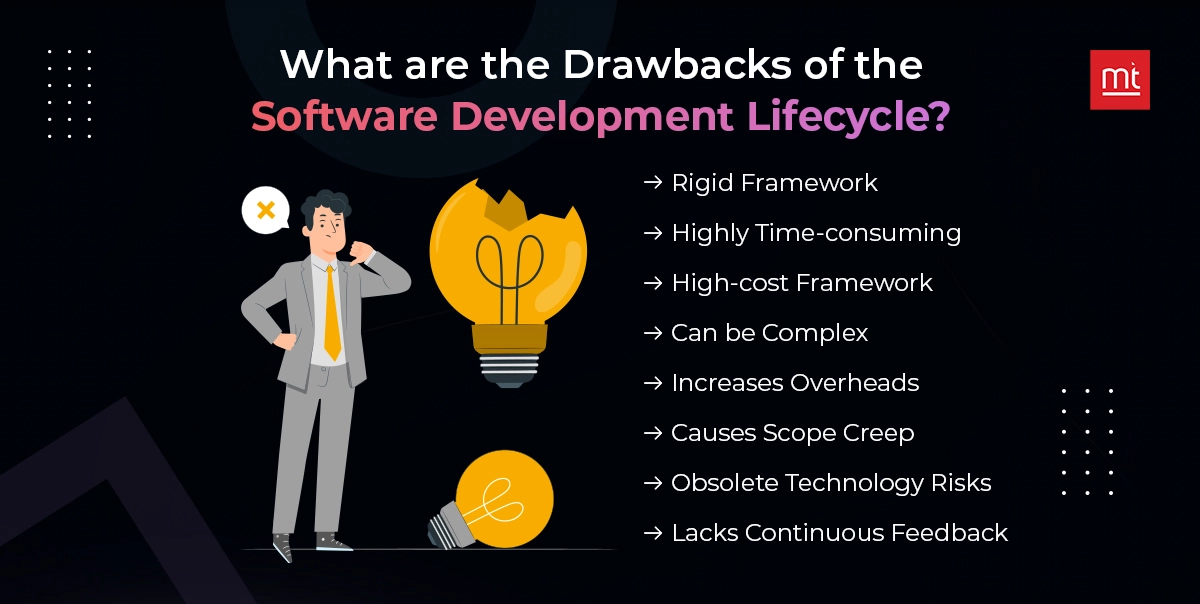
#1. Rigid Framework
SDLC comprises several methodologies, each taking a different approach to complete the app development. However, some methodologies, especially waterfall methods can be quite rigid. It is difficult to accommodate changes or tests while developing in this case.
You may need to go with the entire development before you can test the software, which is one of the biggest drawbacks of SDLC.
#2. Highly Time-consuming
One of the drawbacks of taking this approach is that it can be time consuming. You might need to undergo extensive planning and documentation before proceeding with actual development. This can make it tedious for the development team.
#3. High-cost Framework
While you would allocate the resources properly with this framework, it can cost you a lot in some cases. You might need to spend a lot of time on planning and documentation. This can take up effort and resource time as well.
#4. Can be Complex
If you want to implement SDLC in your app development project, you need someone with specific knowledge and expertise. It is impossible to work with someone who has half baked knowledge. This is especially true when you are working with large-scale complex projects.
If the person doesn’t have the requisite expertise, you might increase the complexity of the scope.
#5. Increases Overheads
When you are working with the SDLC approach, you need to use specific resources in planning and documentation. You also need specific resources to define the scope. This can increase the project overhead.
#6. Causes Scope Creep
You begin working on the software project only after defining the scope. This means you cannot accommodate changes once the scope is defined. In case you begin needing changes while developing, it can add to the costs. This level of scope creep can cost you more.
#7. Obsolete Technology Risks
There is a risk of working with obsolete technology while developing your software solution. This can increase the length of the software development. As a result, you will encounter delays in the long run.
#8. Lacks Continuous Feedback
You are likely to get continuous feedback when you use Agile methodologies to create the software. However, it is possible that the other methodologies aren’t very feedback oriented. As a result, you may not be able to continuously improve the software.
The Phases of the Software Development Life Cycle
There are seven phases of software development life cycle. Each phase or stage is crucial in creating and delivering a high-quality software solution.
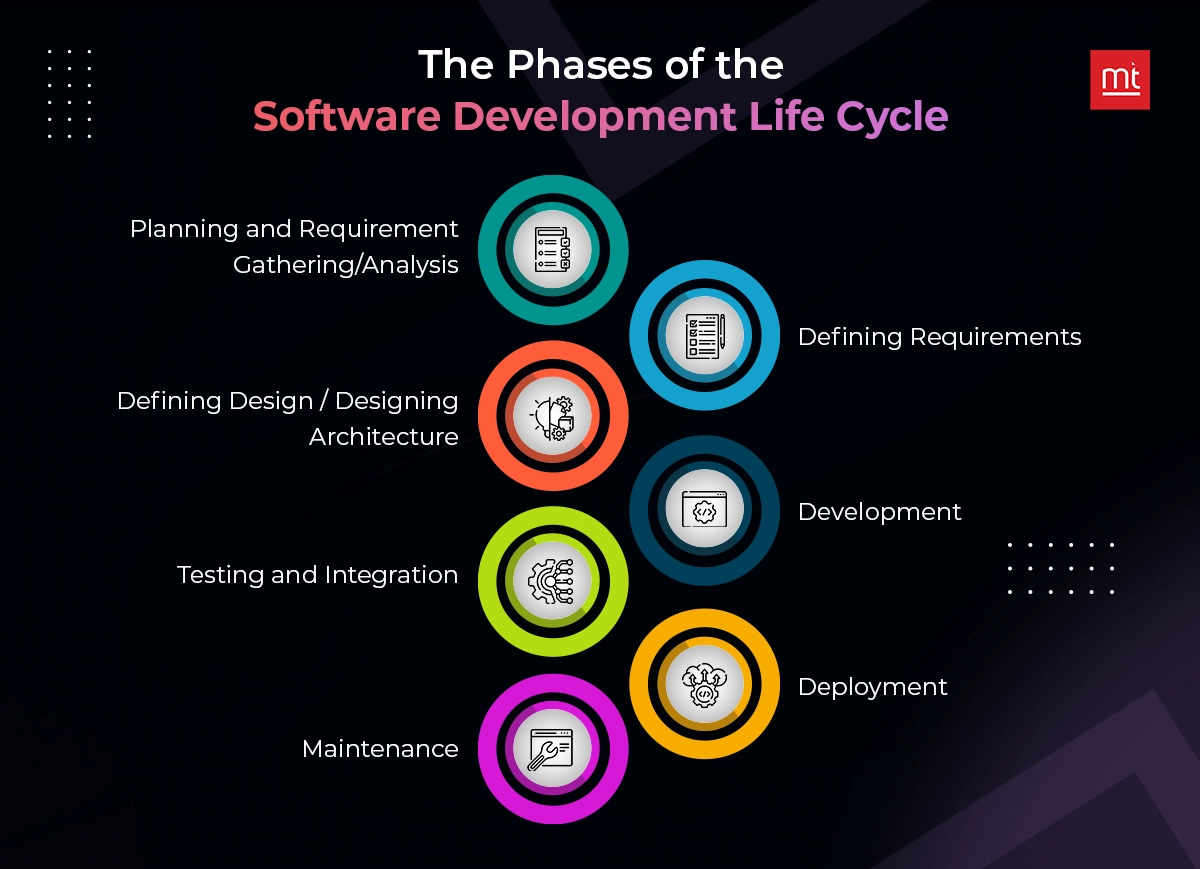
#1. Planning and Requirement Gathering/Analysis
This is the most crucial phase, it decides the path for software development. You will be defining the requirement for the software, the purpose of building the solution and the end goals during this phase.
Based on the stakeholder’s understanding and customer feedback, you will identify the pain points they face due to the lack of software. This is also the stage where you will plan the resources, budget and tools for the development.
The quality of planning will help realise if you can deliver a good quality project.
#2. Defining Requirements
The software requirement specification is a document that supports the developer throughout the development process. This document helps define the requirements based on the initial planning and understanding stages.
You will define the exact features, plan the outline/skeleton for the software and specify the components to be created. The requirements proposal is defined in sync with the users and other stakeholders.
#3. Design / Designing Architecture
This is the stage when the designers begin working on the architecture and prototype for the software solution. The SRS document is key in defining the design for the software solution.
At this stage, the interface for the software as well as the user experience are planned out. There are several prototypes that are laid to begin with. This can help deliver the ultimate software solution.
The designers may use feedback to pick out the most relevant and unique design that fits their needs.
#4. Development
The functional part of the software development begins in this phase. The programmers will begin coding the design, especially the parts that interact with the users. They will use the debuggers, compilers and interpreters to produce the code at this stage.
They will be using popular tools like C/C++, Java and Python to deliver the software solution. The programmers will follow a set of tools or instructions to deliver the solution.
#5. Testing and Integration
This is a crucial phase of the software development process. This is the phase when the developers will suggest and test the quality of the solution. They will identify the bugs and issues in the software and fix them.
At the same time, this phase also involves understanding if the users are ready to embrace the application by testing for user-friendliness and usability.
The testing and third-party integrations are key to ensure that the software is aligned to the user’s requirements.
#6. Deployment
The software developer would have defined the strategy for deploying the application. This strategy is used to deploy the software in phases and offer the final release. The deployment stage is carried out after the testing is complete.
This is also the stage when the company is likely to gain feedback from the customers, which will help them improve the product.
#7. Maintenance
This is the last stage of SDLC. This is when you must ensure smooth performance and regular updates. You must continuously improve the software to meet the unique requirements of the users in this stage.
Software Methodologies to Know
The software development life cycle comprises several models and methodologies. Each of these software development lifecycle methods are different and uniquely useful. Some are genuinely flexible while there are others that make SDLC rigid. Let’s look into each model in detail.
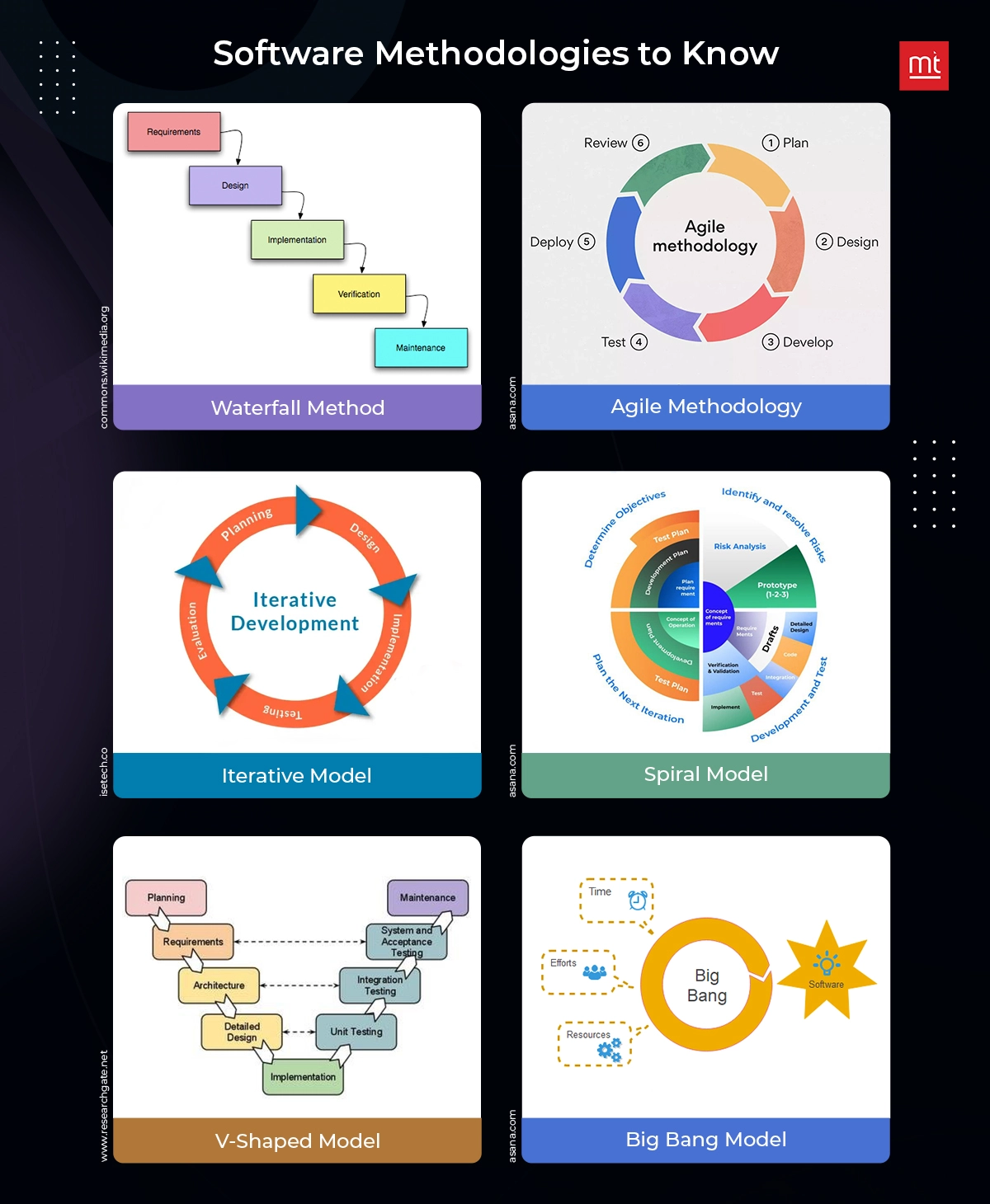
#1. Waterfall Method
The waterfall method or traditional software development life cycle is a sequential process. In this case, the project progress is unidirectional. For instance, you can move to design only after you have finished with requirements gathering.
Each milestone completion is crucial for the developers to progress into the other. This makes the waterfall method inflexible and linear. You can adopt this method if you know the project requirements and are sure there would be no changes going further.
You will get clear milestones for each phase and can fix the deliverables in advance. This would help you identify the expectations at the end of the phases.
This method is best fit when you are dealing with mid-sized projects where the goals are clear and deliverables fixed.
Pros | Cons |
It is simple and easy to interpret because of the linear graph | You cannot accommodate changes once you have started the project, making it inflexible |
You can use it for small or mid-sized projects where requirements are clear | It can lead to increased customer dissatisfaction as they cannot offer feedback till end of project |
It comes with well-defined goals and deliverables making it easier to measure project progress | This methodology doesn’t involve prototype development, which can cause design issues. |
#2. Agile Methodology
One of the most commonly used methodologies in modern software development is Agile. It is flexible and promotes collaboration. Moreover, they use the iterative method to develop the entire software.
Each iteration ends with customer feedback, which makes it easy to continuously develop and improve the code. The developer will take about two to four weeks to finish an iteration.
Owing to the continuous feedback and adaptation in the development process, this methodology guarantees high-quality output.
Pros | Cons |
It is a highly flexible model that allows you to incorporate customer changes and improve the product accordingly. | You need an experienced team to back your agile development processes |
Owing to regular feedback and iterative development, you will ensure positive responses | It may be difficult to predict the cost and timeline for the project owing to the increased flexibility. |
This model offers incremental releases, which allows you to accelerate go-to-market time | The methodology emphasises extensive documentation. This may cause increased misunderstandings in the future. |
You can identify and mitigate the risks, which helps improve the development cycle. | If you don’t work in a controlled manner, it can cause scope creep in software development. |
#3. Iterative Model
In this development approach, the entire process is divided into smaller and easily doable cycles. These are known as iterations. These iterations are like a complete cycle that follows requirement analysis, design, coding, testing and deployment.
However, iterations don’t follow a linear cycle. They tend to come back to the coding or design phase based on the customer’s feedback. They are adaptive and easily implement the essential changes.
Pros | Cons |
It is highly flexible as you can make changes during development based on feedback | It can be complex as multiple iterations are involved in the development process. |
It accelerates the time-to-market the solutions, ensuring quicker delivery and deployment | You need an experienced team to manage the iterative development approach |
It allows you to identify the bugs and issues in the early stages, thus ensuring your project doesn’t fail | You may find it highly expensive as it is tied to continuous testing and integration |
Owing to continuous testing and feedback, you can enhance the quality of the solution | You need more control else you may find that the iteration alters the scope and increases the cost/timeline. |
#4. Spiral Model
The spiral model was developed to ensure minimum risks and maximum customer satisfaction. It combines the traditional waterfall methodology and iterative method to create the application.
It is best fit for large projects, where complexity is high. As the name suggests, it is structured like a spiral and the loops represent the phases in the development process.
It is a four-phased model, where planning and risk analysis are crucial. It analyses the scope risks and alternatives before proceeding with the design and feedback.
Pros | Cons |
This model is developed around risk management, thus ensuring quick bug identification and mitigation. | It is not suited for small projects, as it can get complex and difficult to interpret. |
It is flexible, allowing major requirements and design changes | The risk analysis and prototyping can be expensive, thus increasing overheads. |
You can deliver high-quality projects as you assess and strategize for the risks and issues. | You will note that it is a time-consuming project, as risk analysis can take a long time. |
#5. V-Shaped Model
This model is known as the verification and validation model. It is akin to the waterfall method, just extends into a few more phases.
You can use it if you wish to implement a systematic and structured approach to development. You will be adding a few more phases, such as verification and validation. This would help you understand if the customers are ready for the software solution.
This model prioritises prototype development and user acceptance, which leads to increased satisfaction.
Pros | Cons |
It helps determine the bugs in the early stages, thus reducing rework and costs | It is an inflexible approach, as you cannot go back and change the code without impacting the project. |
The model follows a sequential path, thus making it easy to interpret | You may spend a little more on testing and documentation. |
The test-based development approach allows you to test at the end of each phase, this ensures, your software is completely verified. | It is not suited for complex or large-scale projects. |
There is extensive documentation backing the development, making the requirements and design clear. | You cannot access customer feedback till the end of the project. |
#6. Big Bang Model
This is an informal and simple approach to software development as it relies on limited planning. The development approach depends on a vague understanding of the requirements. The design and coding are approached simultaneously.
There is no formal structure or documentation to this development approach. This approach is dependent on the developer’s intuition and experience. That’s why it is ad-hoc and simple.
Pros | Cons |
You can start with development almost immediately using this approach. | The risk of failure is higher in this case as there is no planning or testing involved. |
It is flexible as it allows you to incorporate changes during the project. | The quality assurance is inadequate as the testing is limited. |
It is best fit for small projects with basic requirements. | It cannot be used for large-scale projects with complex needs. |
Best Practices for Software Development
If you want to deliver a high-quality software solution, you must incorporate the best practices for software development throughout the development.
- You must implement version control systems, such as Git to manage the code changes. This will help you collaborate with developers and track the changes made to the source code.
- Automate the testing practices to ensure quicker validation and improved code quality. It will help detect the bugs faster.
- You must conduct multiple code reviews and identify the issues. Make sure your code adheres to the standard practices.
- It is crucial to implement the CI/CD pipelines in the testing and deployment for rapid releases and reliable development.
- You must work with agile methodologies to foster an iterative and collaborative development environment.
- Maintaining the documentation is crucial as you can define the project requirements and design decisions. This will help with maintenance and future code changes.
- Implement the security best practices like regular audits, secure coding guidelines and vulnerability tests to ensure data integrity.
- Ensure complete performance optimization to deliver an efficient software solution.
- Implement the design pattern and architectural principles to encourage code reusability and promote scalability.
- Invest in user experience design to create more intuitive and user-friendly designs that meet the user’s expectations.
How can ManekTech help with Software Development Life Cycle (SDLC)?
ManekTech is a leading software development company that extends a wide range of services and expertise.
Our team can help with each phase, from requirements gathering to maintenance. They will closely work with your teams and business analysts to manage the development processes. They can help determine the goals, timelines and deliverables using the planning phase.
Our team’s extensive experience in delivering unique and highly innovative software will help you stand out. Their understanding of the design and coding will ensure you have reliable and stable software.
The team can help automate the testing pipelines and ensure thorough tests for the software. They will identify and remove the bugs in the early phases to deliver a capable solution.
Their intervention and ability in each phase will ensure professional project management and highly efficient processes.
Conclusion
Software development lifecycle is a systematic and highly-defined process that enables developers to create high-quality software. There are multiple phases, such as planning, implementation and testing involved in creating the software.
This structured approach allows you to minimise resource utilisation while delivering robust solutions. This approach also allows you to manage the resources and minimise risks. This approach will enhance the productivity of the entire team.
However, to deliver as per needs, you must collaborate with an expert custom software development company. ManekTech is a leading development provider with extensive expertise. Hire dedicated developers with extensive expertise and in-depth experience to create the best solutions for your business.

Subscribe to Our Newsletter!
Join us to stay updated with our latest blog updates, marketing tips, service tips, trends, news and announcements!



